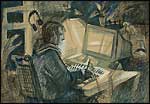In the first acknowledgment of congestion at Apple retail stores, the company announced today that it is now blocking access to the MySpace Web site from stores’ display computers. “Nearly 2 million people visit Apple stores every week. We want to provide everyone a chance to test-drive a Mac, so we are no longer offering access to MySpace in our stores,” the company said. Up to now, the stores have not restricted access to the Internet, which is part of a deliberate strategy to attract visitors, create buzz, and make the stores a destination spot. That philosophy has indeed generated visitors, but it has also meant that display computers were unavailable for those wanting to investigate a computer purchase.
The number of visitors to the stores has continued to increase, both in total and per-store. Apple tallied 81.1 million visitors during fiscal 2006, compared to 50.7 million the year before. On a per-store basis, visitors jumped from 372,700 in fiscal 2005, to 491,500 in 2006, an increase of 31.8 percent.
In April 2006 information surfaced that various social networking Web sites were blocked at Apple stores. However, it was learned that the restrictions were unofficial, imposed by individual store managers to regain access to display computers for potential buyers. Tipsters said that retail executives told the mangers to remove the blocks to allow full Internet access.
A visit to any store–but particularly flagship stores–will find that all computers are occupied by people checking their Hotmail or Gmail accounts, snapping pix with PhotoBooth, writing memos with Word, or surfing various social networking sites. In many cases, computer users are literally camped at a computer, with coffee cups, notebooks, bookbags and other personal property strewn across the display tables.
The issue of store congestion has been raised before within Apple. During a September, 2006 talk to financial analysts, Sr. V-P Retail Ron Johnson said that Apple store customers love the free Internet access. “The question I get all the time is, ‘The store’s too crowded. How do people buy anything?’ But we all know what we like–we like busy places,” Johnson said. He continued, “Free Internet access is the way we bring people into our stores. And people touch a Mac for the first time and they go, ‘Wow! That’s just like my computer. Macs and PCs aren’t that different.’ Big part of the story.”
During his talk, Johnson recalled the origins of the retail store initiative. He recalled thinking, “We’re going to break the norm. We’re going to be a store for everyone. PC owners, Mac owners. Small business, consumers. Eighty year-olds trying to connect with their grandkids. Grandkids trying to get on a computer for the first time. Forget the conventional wisdom of retail that it’s all about specializing.” He imagined the stores as a public place, like a library, where people could come to visit and participate. “What if we built a retail strategy that was a place to belong? What if our store was really a part of the community…it’s was a place to be, not just a place to buy?” he explained to the analysts.
When I visited the San Francisco store last Christmas, I found the full range of users at the display computers, preventing their use by anyone interested in a purchase. I also found the same situation at the SoHo (NYC) store when I visited last May, just after the new black MacBooks were introduced. There wasn’t a free computer among the 70 or so on display, and there were two or three persons standing behind each user waiting their turn. When I visited the Regent Street (London) store last March, I found that computers no the ground floor were unblocked, but that some on the second level near the theater were blocking some major Web sites.
Bandwidth at the stores is apparently not an issue. Speed tests at most stores consistently show 2 Mbps uploads and downloads.
link

Tuesday, May 29, 2007
MySpace Officially Blocked at Stores
Posted by
Valery
at
4:18 PM
![]()
Subscribe to:
Post Comments (Atom)



No comments:
Post a Comment